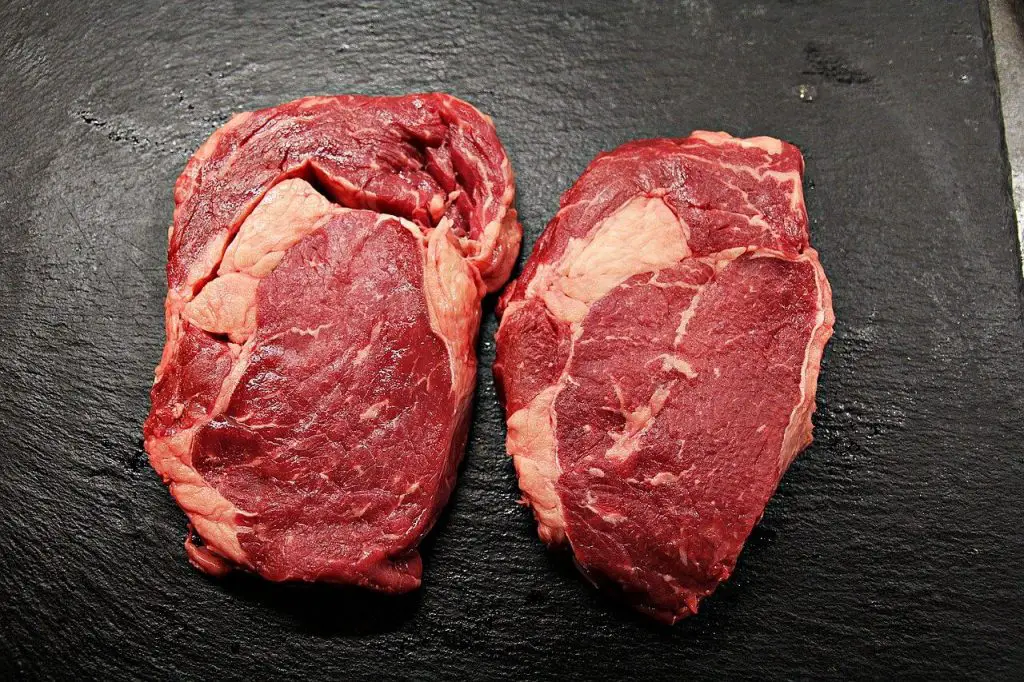If you find yourself becoming a little squeamish about the red juice that’s in your steak, don’t worry, you’re in the right place.
In this article, we’re going to answer a popular question we are asked regularly, what is the red juice in steak?
In a nutshell, it’s myoglobin. The redness in your steak is essentially water, and a protein found in muscle tissue (myoglobin).
Let’s take a closer look…
Contents
It’s Not Blood
Nobody would blame you for presuming that the juice coming out of your steak is blood. It’s red, looks like blood, and would make complete sense.
But it’s not, phew! So it’s time to stop calling that steak of yours bloody! Because the truth is almost all of the blood is taken out in processing, long before it ever reaches your plate.
It can be quite off-putting at the thought of blood sloshing around in your steak and getting on your fingers during the cooking process.
But thankfully almost 75% of that is in fact water, and there’s likely not a single drop of blood in that packet of steak.
So What Is The Red Juice In Steak?
That red juice in your steak is Myoglobin, which is a protein that’s responsible for transporting oxygen in the muscles.
It’s found in almost all mammals, including humans, where it plays an important role in muscle function.
Myoglobin is rich in iron, which gives it that brilliant red coloring. So each steak you consume might include half a milligram of iron!
The reason Myoglobin is often confused with blood is that just like hemoglobin, which is a protein that transports oxygen in the blood, it turns red when exposed to oxygen.
For this reason, Myoglobin is found in abundance in the muscles of animals that need to move large distances or hold their breath underwater for long periods.
The oxygen-carrying protein also provides an important energy source for these animals.
Does Myoglobin Affect The Steaks Taste?
Myoglobin doesn’t actually make our steaks taste any different than if it was not present.
The main determinant of steak flavor is the aging process (for at least several days), which actually breaks down the chemical bonds in Myoglobin.
According to research, this breakdown turns the meat’s grayish color into a brown or purple hue.
As for how long you should age your beef, well that depends on personal preference; it can range from between 3 to 30 days.
How To Keep Myoglobin From Browning Your Steaks?
Luckily, there are several ways to prevent the browning of your meats, during cooking or otherwise.
One method is through marinades, which involves soaking the meat in a solution of oil, lemon/lime juice, salt, pepper, and other spices.
Another way is to simply cook the meat thoroughly, in order to denature the protein.
This means that you’ll thoroughly cook off the Myoglobin before it has time to break down, causing your meats to stay red.
However, if you like rare/medium-rare steak (meaning under-cooked), then the best way to prevent this chemical reaction is to simply not use high heat while cooking.
If you use low temperatures, while cooking your steaks (searing on the outside), rather than using extremely high heat (searing on the outside and leaving it raw in the middle), then you will also ensure that your meats stay nice and red.
Is Myoglobin Good For Us?
The red juice inside steak is surprisingly good for us, it’s full of protein, minerals, and vitamins which are all good for the human body.
Its iron-rich properties can help to prevent fatigue, it contains high levels of vitamin B12 for maintaining red blood cell health, amino acids which are important in muscle recovery after strenuous exercise or injury, B6 which helps the formation of red blood cells.
Myoglobin is also perfect for those with anaemia, as well as people that are pregnant or underweight due to its high iron content.
Although steak is known for being extremely good food unless you cook your steaks the right way it can be bad for us.
If you over-cook your steak you will find yourself eating more calories than if cooked more on the rare side.
This is because the meat becomes more difficult for our bodies to digest due to the fat content of beef.
So even though red juice in steak is usually perceived as a negative point, it can also be seen as a positive one if you cook it right.
Myoglobin Adds To The Flavor
When cooking steak, keep in mind that this red juice is myoglobin, which works with the fat of beef to create its flavor.
You can test this by cooking your steak for different amounts of time and not eating that certain section.
If you notice that the meat has a gamey taste, it’s likely due to iron content, but if the meat still tastes normal then it was cooked correctly.
Also, make sure to cook your steak rarer than you would like because as we all know too well – cold steak is much better than overcooked one!
The amount of red juice you’ll find in steaks largely depends on the quality of the cut. For example, filet has very little to no juice because it’s fatty meat that doesn’t need that much saturation for it to become tender.
This is exactly why sirloin steak is more flavorful than filet but costs less because it requires more blood supply which originates from an animal’s legs, shoulders, and back (where all the tough muscles go)
Other beef cuts like ribeye or t-bone are known for their large amount of flavor-packed juice.
The best parts of a cow to get red juice in them are chuck shoulder clod top blade shoulder petite tender picnic.
It’s also good to know that other meats like lamb and pork contain practically none at all!
Other Considerations
It’s also worth considering that steak often comes with a sauce and perhaps vegetables, so the red juice in steak added to everything else can add up.
The other thing to take into consideration is that we eat all kinds of things every day – some good for us and some bad – so cutting down on one food group (meat) isn’t necessarily the best approach.
Steak is a great source of protein and iron, and we need to eat a little fat every day.
Lastly, you should always make sure your steak is cooked through before serving!
Red juice in steak is not like blood – it’s just water that comes out of the meat when you cook it. It also adds flavor to the dish, and has lots of nutrients and goodness, so don’t be afraid of it!
Conclusion
In conclusion, steak is a healthy dish that contains some fat, but also many essential nutrients and vitamins, so it’s absolutely worth incorporating into your diet.
The red juice in your steak is myoglobin mixed with water, this juice is red because of the iron in myoglobin.
Since it is not blood, you do not have to worry about the health concerns associated with consuming blood!
Myoglobin absolutely not blood, so try to remove that thought from your mind (I know it’s hard!) when you’re eating steak.
Hopefully, this post has answered, what is the red juice in steak? And you now know that this juice is not blood and simply myoglobin.
Thanks for taking the time to read this post and feel free to share with someone who may find it of value.

